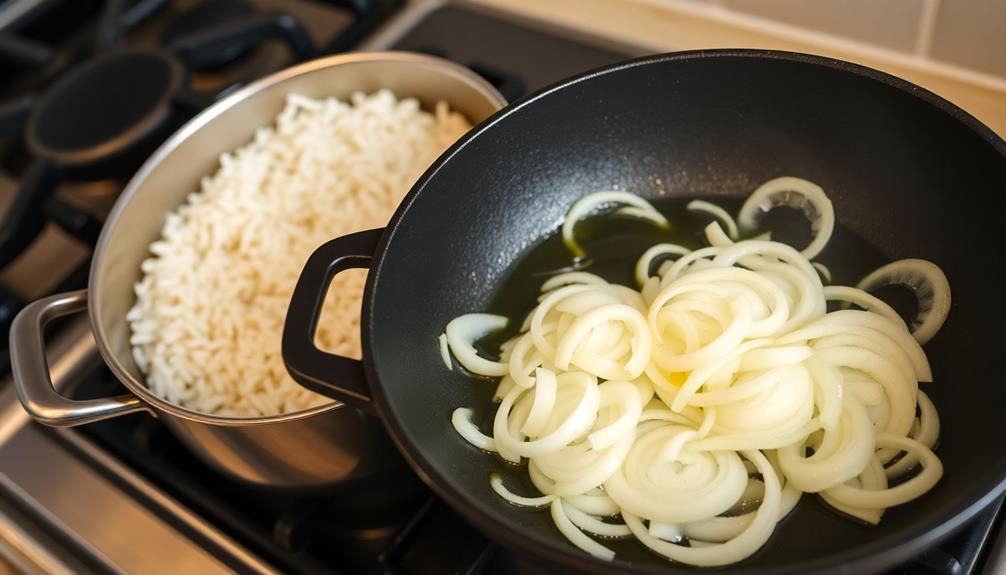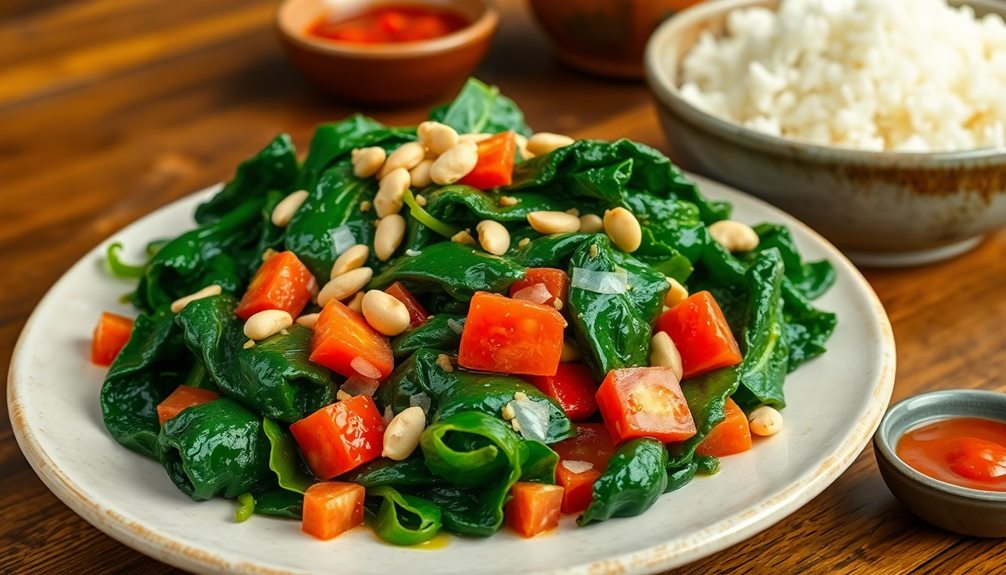Senegalese thieboudienne is the national dish of Senegal, a vibrant fusion of fresh fish and aromatic rice that's steeped in rich cultural heritage. Hailing from the island city of Saint-Louis, this beloved dish derives its name from the Wolof words for "rice" and "fish." Women traditionally prepare it over open flames using local ingredients, showcasing the community's culinary expertise. The dish boasts regional variations, reflecting Senegal's diverse agricultural and maritime resources. Thieboudienne's striking presentation and mouthwatering aromas embody the pride and identity of the Senegalese people. Want to discover more about this captivating culinary delight? Look no further than the Senegalese yassa chicken recipe, another iconic dish that captures the essence of Senegalese cuisine. This flavorful dish features marinated chicken, tangy onions, and zesty spices, creating a tantalizing blend of flavors. Whether you’re drawn to the thieboudienne or the yassa chicken, exploring Senegal’s culinary traditions is a delicious journey of discovery.
Key Takeaways
- Thieboudienne is the national dish of Senegal, originating from the island city of Saint-Louis and derived from the Wolof words "tiebou" (rice) and "jën" (fish).
- The dish is traditionally prepared by Senegalese women using fresh local ingredients, emphasizing the role of community and family in its preparation.
- Thieboudienne features a vibrant presentation and aromatic qualities, symbolizing pride and identity for the Senegalese people and their rich agricultural and maritime resources.
- The preparation of Thieboudienne requires patience, skill, and a deep understanding of flavor interplay, as each ingredient plays a crucial role in the final dish.
- Thieboudienne fosters connections among diners, often served in communal settings that promote sharing, storytelling, and the celebration of cultural identity and family traditions.
History
Thieboudienne, the national dish of Senegal, has a rich history that dates back centuries. It's believed the dish originated in Saint-Louis, an island city located at the mouth of the Senegal River. The name "thieboudienne" is derived from the Wolof words "tiebou" meaning rice and "jën" meaning fish.
This iconic dish was traditionally prepared by Senegalese women who'd gather the freshest ingredients from local markets and cook them over an open flame.
Over time, thieboudienne has evolved, with different regions developing their own unique variations. In the seaside town of Joal-Fadiouth, the fish is often smoked, while inland areas may use dried fish or even meat.
Regardless of the specific ingredients, the dish remains a beloved symbol of Senegalese culture, bringing families and communities together around the table.
Today, thieboudienne continues to be a source of pride and an important part of Senegalese culinary heritage.
Recipe
Thieboudienne is a beloved national dish of Senegal, a fragrant and flavorful one-pot meal that combines rice, fish, and an array of vibrant vegetables. This iconic dish has its roots in the Wolof culture and is often enjoyed as a communal feast, bringing families and friends together around the table.
At its heart, thieboudienne is a celebration of the bountiful produce and seafood that flourish in the West African region. The dish's name is a combination of the Wolof words "ceeb" (rice) and "jën" (fish), reflecting the central ingredients that give this dish its distinctive character.
- 1 whole fish (such as snapper, grouper, or tilapia), cleaned and cut into portions
- 1 cup long-grain white rice
- 1 onion, diced
- 3 tomatoes, diced
- 1 green bell pepper, diced
- 1 carrot, peeled and diced
- 1 eggplant, diced
- 2 cloves garlic, minced
- 1 habanero or other hot pepper, finely chopped (optional)
- 2 tablespoons tomato paste
- 1 tablespoon peanut oil
- 1 teaspoon salt
- 1 teaspoon black pepper
- 1 cup fish or vegetable broth
To prepare the thieboudienne, start by simmering the rice in the fish or vegetable broth until tender, about 20 minutes.
Meanwhile, in a large pot, sauté the onion, garlic, and hot pepper (if using) in the peanut oil until fragrant. Add the diced tomatoes, bell pepper, carrot, and eggplant, and cook for 10-15 minutes, or until the vegetables are tender.
Nestle the fish portions into the vegetable mixture, then stir in the tomato paste and season with salt and pepper. Cover and simmer for 15-20 minutes, or until the fish is cooked through and flakes easily with a fork.
When serving thieboudienne, it's customary to present the dish with the fish portions arranged atop the rice, creating a visually stunning and appetizing presentation.
Accompany the meal with a vibrant side salad or a dollop of spicy, peppery sauce for those who enjoy an extra kick of flavor.
Cooking Steps
First, soak the rice in water overnight and drain it.
Then, sauté the onions in a pan.
Next, add the chopped vegetables, fish, and seasoning, then simmer the dish for 30 minutes.
Step 1. Soak Rice in Water Overnight

Soak the rice in ample water overnight. This crucial step allows the grains to absorb moisture, ensuring they'll cook evenly and achieve the desired fluffy texture.
Don't skimp on the water – you want the rice to be fully submerged. Once you've added the rice, cover the bowl and let it sit at room temperature for 8 to 12 hours. This extended soaking period helps soften the grains, making them more receptive to the flavorful broth during the cooking process.
In the morning, you'll notice the rice has expanded and become more pliable. Drain the rice thoroughly, discarding the soaking liquid. This step sets the stage for the rice to perfectly complement the robust flavors of the thieboudienne dish.
With the rice prepped, you're one step closer to enjoying the authentic taste of Senegal.
Step 2. Drain Rice, Then Sauté Onions

After draining the soaked rice, it's time to sauté the onions.
Grab a large skillet or pan and heat it over medium-high heat. Add a few tablespoons of vegetable oil or butter.
Once the oil is hot, toss in the sliced onions. Sauté the onions, stirring frequently, until they become soft and translucent, about 5-7 minutes. Be careful not to let them burn.
Next, add any additional aromatics you're using, such as garlic, ginger, or spices.
Sauté them with the onions for 2-3 minutes, allowing the flavors to meld. The onions should now be nicely caramelized, adding depth and sweetness to the dish.
Step 3. Add Chopped Vegetables

Once the onions are caramelized, you can start adding the chopped vegetables. Begin by tossing in the diced tomatoes, ensuring they're evenly distributed throughout the dish.
Next, add the carrots, bell peppers, and eggplant, sautéeing them until they're tender-crisp. Be mindful not to overcrowd the pot, as you want the vegetables to have enough space to absorb the flavors.
As the vegetables cook, stir in the chopped parsley and green onions. Their fresh, vibrant notes will brighten the dish and complement the other ingredients. Remember to season with salt and pepper to taste, adjusting the seasonings as needed.
The combination of the sautéed onions, the juicy tomatoes, and the assortment of tender-crisp veggies will create a flavorful, textured base for the thieboudienne.
Continuously stir the mixture, allowing the flavors to meld and the vegetables to become perfectly cooked. This step is crucial in building the depth of flavor that will make your Senegalese thieboudienne truly exceptional.
Step 4. Add Fish and Seasoning

With the vegetables now perfectly cooked, it's time to add the star of the dish – the fish. Typically, thieboudienne features a variety of white fish, such as snapper, grouper, or tilapia. Carefully place the fish fillets into the pot, nestling them among the vibrant vegetables.
Sprinkle the fish generously with a blend of Senegalese spices, including smoked paprika, cumin, and cayenne pepper. These bold flavors will infuse the fish, creating a delightful contrast to the subtle sweetness of the vegetables.
Next, pour in the seasoned fish stock, ensuring the liquid covers the ingredients. Bring the pot to a gentle simmer and allow the fish to poach in the aromatic broth, gently cooking until it flakes easily with a fork.
As the fish simmers, the flavors will meld and deepen, creating a truly harmonious dish. Finally, stir in a touch of lemon juice to brighten the overall flavor profile, and season with salt and pepper to taste.
Step 5. Simmer for 30 Minutes

Simmer the dish for around 30 minutes, allowing the flavors to meld and the fish to cook through.
Reduce the heat to medium-low, ensuring the liquid doesn't boil too rapidly. Gently stir the mixture occasionally, being careful not to break up the fish. The rice should become tender and absorb the savory broth.
As the dish simmers, the aroma of the spices and herbs will fill your kitchen, tantalizing your senses.
Continue to cook until the fish is flaky and the rice is cooked through. Taste and adjust the seasoning as needed, adding more salt or pepper to suit your preferences.
The long, slow simmering allows the complex flavors to develop, creating a truly authentic Senegalese thieboudienne.
Once the time is up, your vibrant, fragrant dish will be ready to serve, a celebration of the rich culinary traditions of Senegal.
Final Thoughts
As we wrap up our exploration of thieboudienne, consider how this iconic Senegalese dish has woven its way into the cultural fabric of the country.
Beyond its mouthwatering flavors, thieboudienne represents the rich diversity and resilience of Senegalese cuisine. It's a testament to the nation's culinary heritage, passed down through generations and adapted to local ingredients.
Preparing thieboudienne is an art form, requiring patience, skill, and a deep understanding of the interplay of flavors.
Each step, from simmering the fish to layering the vegetables, contributes to the dish's harmonious balance. It's a culinary experience that transcends the plate, connecting people to their cultural roots and fostering a sense of community.
As you savor the last bites, remember that thieboudienne is more than just a meal – it's a celebration of Senegalese identity, a living tradition that continues to nourish the body and soul.
Embrace this flavorful journey, and let it inspire you to explore the depths of Senegalese cuisine.
Frequently Asked Questions
What Is the Cultural Significance of Thieboudienne in Senegal?
Thieboudienne is a cherished national dish in Senegal, reflecting the country's rich culinary heritage and coastal identity. It's a symbol of cultural pride, uniting Senegalese people through its shared flavors and traditions.
Can Thieboudienne Be Made With Other Types of Fish?
Yes, you can make thieboudienne with other types of fish. The dish's core is the rice and seasoning, so you can experiment with different fish to create your own unique take on this West African classic.
How Long Does It Typically Take to Prepare Thieboudienne?
It typically takes about 2-3 hours to prepare thieboudienne. The dish requires soaking the rice, simmering the fish and vegetables, and assembling the final meal, so it's a bit time-consuming but well worth the effort.
Are There Any Dietary Restrictions or Variations of Thieboudienne?
Dietary restrictions may include avoiding certain fish or ingredients based on cultural or religious beliefs. Some variations may substitute rice with other grains or make the dish vegetarian by omitting the fish.
Where Can One Find the Best Thieboudienne in Senegal?
Where can you find the best thieboudienne in Senegal? The locals will tell you to head to Saint-Louis or Dakar, where you'll find authentic and mouthwatering versions of this beloved national dish.










